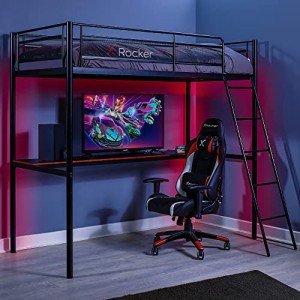The Ultimate Guide to Bunk Beds for Kids: Safety, Styles, and Solutions
Bunk beds have actually long been a popular choice amongst parents looking for to optimize space in their kids's bedrooms. With advantages that go beyond their compact style, bunk beds offer a fun and practical sleeping arrangement while encouraging brother or sister bonding and fostering creativity. In this comprehensive guide, we explore different elements of bunk beds for kids, including security considerations, various styles readily available, and recommendations for picking the ideal one for your family.
Why Choose Bunk Beds?
Bunk beds are developed to stack one bed on top of another, making use of vertical space to produce more room for play and storage. They are especially beneficial for households with numerous children or limited bed room space. In addition, they offer a daring sleeping environment that children typically enjoy.
Secret Advantages of Bunk Beds:
- Space-saving style: Ideal for small rooms or shared areas.
- Cost-effective: Often more inexpensive than purchasing 2 separate beds.
- Motivates social interaction: Promotes bonding amongst siblings or friends.
- Versatile alternatives: Available in various styles and configurations to suit any room design.
Security First: Essential Considerations
When picking a bunk bed for kids, safety needs to be the top concern. The following functions are crucial for making sure a safe and secure sleeping environment:
Important Safety Features:
- Sturdy Construction: Ensure that the bed frame is made from resilient materials such as solid wood or metal.
- Guardrails: Bunk beds should have guardrails on both sides of the upper bunk to avoid falls.
- Ladder Safety: A durable, integrated ladder or stairs with anti-slip rungs is necessary for safe access to the top bunk.
- Weight Limit: Check the manufacturer's weight limit capability for both the top and bottom bunk.
- Mattress Size: Use the correct bed mattress size as specified by the bed maker to ensure a tight fit within the bed frame.
Safety Tips for Parents:
- Monitor Sleep Habits: Teach children the importance of not playing on or leaping off the bunk beds.
- Age Appropriateness: Generally, the upper bunk appropriates for kids aged 6 and older.
- Routine Inspections: Periodically look for any loose bolts, screws, or structural damage.
Designs of Bunk Beds
Bunk beds come in a range of styles, allowing parents to pick one that matches their kid's space design while conference specific requirements. Below are some popular styles:
Popular Bunk Bed Styles:
- Traditional Bunk Beds: Simple and classic designs made of wood or metal with no extra functions.
- Loft Beds: Features a raised leading bunk with space beneath for a desk, play area, or extra storage.
- L-Shaped Bunk Beds: Arranged in an L-shape, often perfect for corner areas and can have additional storage alternatives.
- Twin over Full Bunk Beds: A twin bed on top and a bigger full-sized bed on the bottom, accommodating kids or teens of numerous ages.
- Triple Bunk Beds: Designed to fit three beds in a single footprint, ideal for larger families or sleepovers.
A Comparison of Bunk Bed Styles
| Bunk Bed Style | Description | Best For |
|---|---|---|
| Conventional | Classic style with 2 stacked beds | Standard bedroom setups |
| Loft Bed | Raised bed with usable space beneath | Homework or play areas |
| L-Shaped | Bunk beds arranged in an L-shape | Corner spaces |
| Twin over Full | Twin bed on top, full bed below | Various age brother or sisters |
| Triple Bunk | Three stacked beds | Big households or pajama parties |
Picking the Right Bunk Bed
When browsing for the best bunk bed, think about the list below factors to guarantee you make a notified choice:
Key Factors to Consider:
- Room Size: Measure the room measurements to determine the appropriate size and height of the bunk bed.
- Kid's Age: Consider the age of your child(ren) when picking a design and safety features.
- Functionality: Think about just how much storage or play space you need and whether the bunk bed must serve additional functions.
- Spending plan: Set a budget plan that includes not only the bunk bed however likewise the required bed mattress and devices like bedding or security gates.
FAQs About Bunk Beds for Kids
1. What age is appropriate for a child to sleep in the top bunk?
Generally, kids aged 6 and older should have the ability to securely oversleep the leading bunk, though you must constantly consider your child's maturity level.
2. Are bunk beds safe for young children?
It is not advisable for young children or extremely kids to oversleep the top bunk due to the risk of falling.
3. How do I preserve the bunk bed?
Inspect the bed regularly for any indications of wear and tear, tightening up screws, and cleaning up the mattresses to ensure extended safety and sturdiness.
4. Can I transform a bunk bed into 2 different beds?
Lots of bunk beds are designed to be convertible, enabling you to separate the beds when needed. Check the manufacturer's specs before buying.
5. How can I make the most of space in a bunk bed space?
Utilize under-bed drawers, shelves, or lofted designs to create extra storage options in a space with a bunk bed.
Bunk beds provide a delightful mix of fun, performance, and space-saving energy, making them a perfect choice for young families. By thinking about Bunk Beds Store , numerous styles, and practical elements such as space size and age suitability, moms and dads can choose the best bunk bed for their kid's needs. With the right choice, bunk beds can transform a bed room into a wonderful space that motivates play, creativity, and bonding amongst brother or sisters. Always remember to prioritize safety and upkeep to take advantage of this special sleeping plan.

